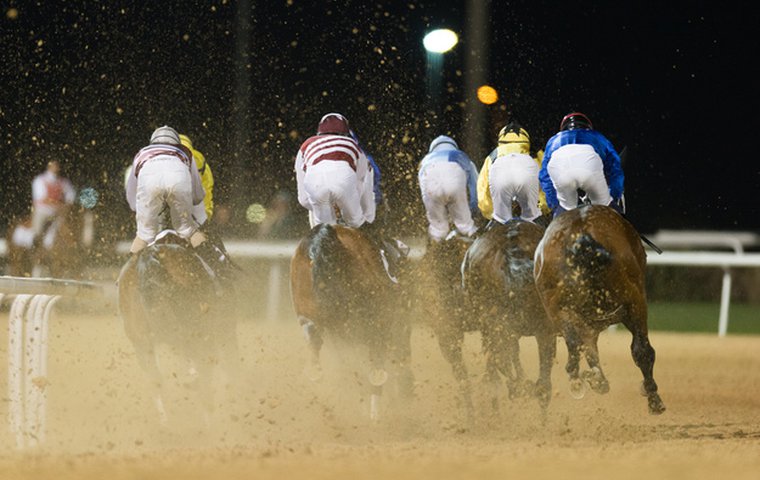
Dubai dirt suddenly riding a lot faster - and that's good news for Chrome & Co.
Last week, the speed of the dirt track at the Dubai Carnival changed significantly. The surface on which the Dubai World Cup itself will be run at Meydan on March 28 went from a dull, tiring track bedevilled by a desert storm of kickback to the kind of footing worthy of fast horses.
This should be a huge relief to the organisers, in my view.
In the first race on the Feb. 26 card, a 5-year-old gelding called Price Is Truth, who had lost his last two races by a combined 59 lengths, drilled six furlongs in 1:10.86. That's worth about 1:08 3/5 in American money, and it earned the son of Distorted Humor a track record by the equivalent of nearly four lengths.
When the top sprinters descend on Dubai from the U.S, Hong Kong, and Australia for the $2 million Golden Shaheen on World Cup night, the track - if maintained in its present state - should allow them to time 1:09 for six furlongs from a standing start. While this is some way removed from the race record of 1:08.01 set by Big Jag at the old Nad Al Sheba Racecourse, remember that they used to run the Shaheen over a straight track, rather than round a bend as now at Meydan.
Had the dirt surface stayed in the same condition, there might have been a problem for the world's richest race day. In January, South African trainer Mike de Kock was so aghast at the state of the surface that he was reported as saying: “We will revise our initial Carnival strategies without delay. Unless there are absolutely no other options, we won't have another entry on dirt this season.”
He later claimed to have been quoted out of context, though it is hard to see how.
De Kock echoed many trainers and jockeys in the early throes of the Dubai Carnival when he railed against the perception of a track bias favouring front runners. “To win on this track you need runners with good gate speed that can jump and lead or sit up second or third. Otherwise, you may as well stay at home.”
In all other output, de Kock has come across as a fine thinker and a shrewd strategist, but his views on the bias were not really justified statistically, and certainly haven't been made to look more prescient in the weeks since. He evidently didn't believe them himself, judging by the participation of several of his stable in dirt races since.
Moreover, there has been a regular supply of horses winning and running well from off the pace. In the second race on the Feb. 26 card, a longshot called Pit Stop took advantage of a torrid pace up front to close strongly from the rear and stop the clock at 1:36.59 for the mile. That was a track record by nearly a second, yet nobody is confusing the 4-year-old with Dr. Fager.
It's my view that the tighter Meydan dirt surface does actually facilitate closing for practical reasons: there isn't a worse shower of kickback to deter late-running horses from facing the pace. Again, this is good news for the World Cup meeting, for the higher the percentage of horses who can give their running, the more competitive the racing.
And competitive races on dirt have been in rather short supply at the current Carnival. My concern at the decision to prematurely rip up the Tapeta surface at Meydan – which did play fairly to horses of all run-styles and track positions – was that competition would suffer, not to mention the aesthetic. I am a big fan of dirt racing when good horses run over the strip, but even useful horses can be reduced to hapless plodders if jockeys get carried away with the need-to-lead dynamic.
I believe my view has been justified. The first two rounds of the Maktoum Challenge – a series of three well-spaced lead-up races to the World Cup – have been dominated by horses who are not close to credible challengers for the $10 million spectacular. OK, this has often been the case in the past as well, but there simply hasn't been the potential for anything significant pre-race this time, and this denies the possibility for genuine excitement.
Surfer, the winner of Round 1 on Jan. 29, was 15th of 16 to African Story in last year's World Cup, and is not likely to take his chance this time around, while Round 2 winner Frankyfourfingers – behind Surfer in Round 1 – is a 25-to-1 shot with most bookmakers, which isn't generous.
Speaking of African Story, last year's World Cup winner on Tapeta, was well beaten on his dirt debut in Round 2, and his odds of making a similar impact on the new surface this year have lengthened. Still, he remains high on Godolphin's list of candidates, according to the betting, along with fellow 8-year-old Prince Bishop, who was narrowly beaten by Frankyfourfingers. It's clear how much depends on the new shooters on March 28.
Certainly, the series of 3-year-old races on dirt has been lacking strength in depth. Local Time, winner of the UAE 1,000 Guineas and Oaks, is a thoroughly professional racehorse and doubtless a very useful one too, but she has beaten bedraggled fields of five and four rivals in these so-called “classics” for fillies. The colts have put on more of a show, with Maftool and Mubtaahij clocking times right up with historical pars. Again, however, greater competition is needed.
This weekend, Medyan stages Super Saturday, which could bolster the picture for World Cup night, if not the main event itself. Hopefully, we will see whether the dress rehearsals for the dirt races produce compelling action now that the surface is a lot faster.


